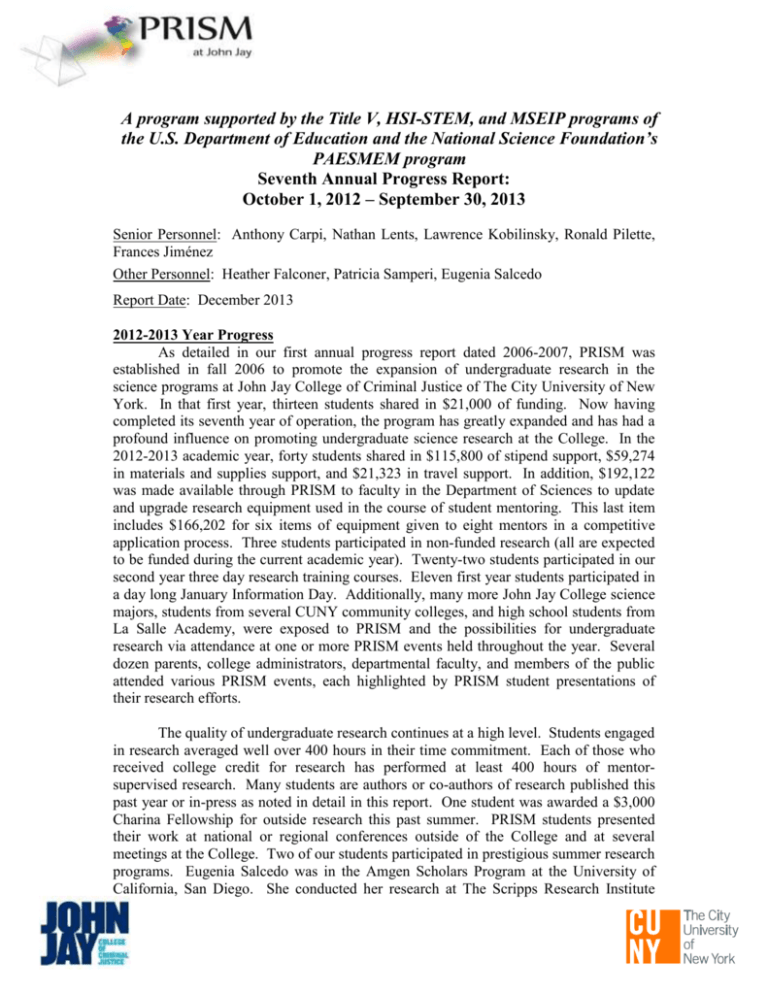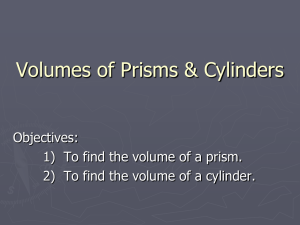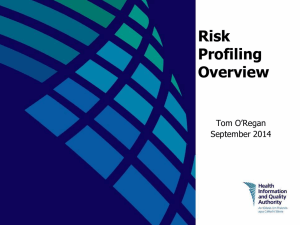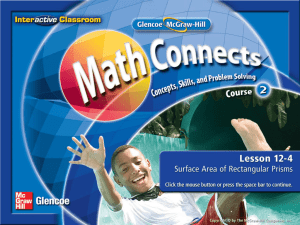2013 PRISM Report
advertisement

A program supported by the Title V, HSI-STEM, and MSEIP programs of the U.S. Department of Education and the National Science Foundation’s PAESMEM program Seventh Annual Progress Report: October 1, 2012 – September 30, 2013 Senior Personnel: Anthony Carpi, Nathan Lents, Lawrence Kobilinsky, Ronald Pilette, Frances Jiménez Other Personnel: Heather Falconer, Patricia Samperi, Eugenia Salcedo Report Date: December 2013 2012-2013 Year Progress As detailed in our first annual progress report dated 2006-2007, PRISM was established in fall 2006 to promote the expansion of undergraduate research in the science programs at John Jay College of Criminal Justice of The City University of New York. In that first year, thirteen students shared in $21,000 of funding. Now having completed its seventh year of operation, the program has greatly expanded and has had a profound influence on promoting undergraduate science research at the College. In the 2012-2013 academic year, forty students shared in $115,800 of stipend support, $59,274 in materials and supplies support, and $21,323 in travel support. In addition, $192,122 was made available through PRISM to faculty in the Department of Sciences to update and upgrade research equipment used in the course of student mentoring. This last item includes $166,202 for six items of equipment given to eight mentors in a competitive application process. Three students participated in non-funded research (all are expected to be funded during the current academic year). Twenty-two students participated in our second year three day research training courses. Eleven first year students participated in a day long January Information Day. Additionally, many more John Jay College science majors, students from several CUNY community colleges, and high school students from La Salle Academy, were exposed to PRISM and the possibilities for undergraduate research via attendance at one or more PRISM events held throughout the year. Several dozen parents, college administrators, departmental faculty, and members of the public attended various PRISM events, each highlighted by PRISM student presentations of their research efforts. The quality of undergraduate research continues at a high level. Students engaged in research averaged well over 400 hours in their time commitment. Each of those who received college credit for research has performed at least 400 hours of mentorsupervised research. Many students are authors or co-authors of research published this past year or in-press as noted in detail in this report. One student was awarded a $3,000 Charina Fellowship for outside research this past summer. PRISM students presented their work at national or regional conferences outside of the College and at several meetings at the College. Two of our students participated in prestigious summer research programs. Eugenia Salcedo was in the Amgen Scholars Program at the University of California, San Diego. She conducted her research at The Scripps Research Institute under mentor Dr. Peter K. Vogt. Her specific project was to identify proteins that interact with pi3 kinase, a protein found mutated in many cancer cells. Eugenia constructed vectors that will allow for the identification of these proteins. Shoronia Cross completed an internship at Princeton University, in the Princeton Institute for the Science and Technology of Materials (PRISM) and Princeton Center for Complex Materials (PCCM) Research Experience for Undergraduates (REU) program. He worked in the Imaging and Analysis Center, under Dr. Nan Yao and Mr. Gerald Poirier. The sixth annual John Jay College PRISM Undergraduate Research Symposium was held on May 3, 2013 as part of the annual college-wide Celebrating Student Research & Creativity week. The PRISM Symposium was attended by over 75 students, faculty, and administrators. The event featured an invited talk from a former John Jay College forensic science undergraduate student, Dr. Lisa DeWald, who earned her PhD in Molecular and Cellular Pharmacology in 2010 from the State University of New York (Stony Brook). Anna Stoll gave an oral presentation as winner of the annual prize for outstanding undergraduate research. Thirty-five PRISM students presented posters at the event. The sheer amount of high quality work has reached the point where we now give runner-up awards for outstanding student researcher and awards for outstanding poster presentation. At the annual day-long PRISM January Information Day for first-year forensic science majors, PRISM students presented posters and discussed their research interests, invited speakers gave talks on career options, and program information was distributed. Second year research training continued, and two three-day long training courses were held in January and June to accommodate all students interested and eligible for undergraduate research. The training courses introduced the process of conducting scientific research, from literature searching to understanding scientific writing, and hands-on laboratory exercises to orient students to laboratory research work. Faculty also discussed the importance of research as well as how they first became interested in science and research. Again, PRISM students presented posters and discussed their research interests. Outreach to partner community colleges continued this year with a focused effort to engage CUNY Justice Academy (CJA) students in activities that would introduce them to John Jay and to our PRISM students. We targeted the same four schools as last year, Bronx Community College (BCC), Borough of Manhattan Community College (BMCC), Queensborough Community College (QCC), and Hostos Community College. Outreach activities included an outing to the Westchester Crime Lab, a visit to the Bronx Zoo, and a lecture outing to the New York Academy of Sciences. Additionally, lab tours for CJA students were held in December and in May. Guests from all community college forensics majors in the CJA were invited to attend the annual PRISM Symposium. The outreach coordinator visited Hostos for their forensics major info session and met with interested students about PRISM and its outreach activities. As in the past, PRISM mentors visited QCC to guest lecture; this year’s fall semester lecturer was Dr. Thomas Kubic and the spring semester lecturer was Dr. John Reffner. 2 There were two initiatives this year designed to engage promising underclassmen at John Jay College as well as the partner community colleges. Both of these built on pilots that took place last year. The first of these initiatives was a seminar, intended as a basic introduction to forensic science for underclassmen. The seminar curriculum was designed by JJC adjunct professor, Alison Domzalski, who also instructed this three-day course that took place in August at John Jay College. A combination of nineteen John Jay freshmen and CJA students participated, learning about each of the three forensic science tracks offered at John Jay as part of the major. The seminar was very well received and is planned again for next summer. The second initiative was our lab shadowing program. Piloted in the summer of 2012, freshman JJC students and CJA students were invited to buddy up with a current PRISM student to spend a block of time observing and when possible, participating in, their research lab activities. Eleven students shadowed PRISM students this past summer and this program will continue during winter break and summer break again this year. In addition to the outreach activities described above, efforts were also made to more actively engage CJA forensics students in opportunities relating to undergraduate research. Students from QCC and BMCC were invited at the beginning of each semester to apply for research stipends allocated by PRISM, for research work to be completed at their own schools. One student from QCC and three students from BMCC were funded for their research. Starting last spring, students from Hostos Community College were invited to apply for a research externship at John Jay and work with a PRISM mentor. One student from Hostos qualified for and participated in this externship. She received funding for her work with Dr. Marcel Roberts and will continue her work with him next spring upon her transfer to John Jay. Of these five total CC students who were funded for their research, the three who conducted research in spring presented posters at the PRISM Symposium. Lastly, we contacted community college partner students who were about to transfer to John Jay in order to invite them to apply to PRISM. Two of these students were funded for their research as new John Jay students and another two participated in the June Research Training Workshop in anticipation of starting research at John Jay in the coming year. The fourth PRISM Chronicle of Undergraduate Research, a publication that includes short biographies and research abstracts of projects undertaken during the 20122013 year, was produced in May of 2013 and distributed at the annual symposium. We continue to publish monthly electronic newsletters for faculty, PRISM students, alumni, and pre-PRISM students. A comprehensive GRE course was offered this past summer with eleven students in attendance. Monthly meetings continued this year during which guest speakers were invited to speak to students about options for graduate school or career goals. Speakers included representatives from the New York Academy of Sciences and the Columbia University Mailman School of Public Health, among others. 2012-2013 was also a year in which significant time was invested in assessment and evaluation of the program and its outcomes. An Assessment Specialist was hired and created a database of program metrics that was reviewed by the project PIs and is now regularly updated to guide data acquisition and analysis. Our first peer-reviewed research 3 publication that discusses PRISM was published in the Journal of Hispanic Higher Education in 2013.1 This manuscript broadly describes the numerous student services created in our science program, and the impact this collection of services has had on endpoints including student retention, post-graduate success, and engagement. A second article, an op-ed piece published in a special diversity-themed issue of the Chronicle of Higher Education was published in October of this year.2 This piece describes the impact the PRISM program has had on the culture of research activity in the Department and at the College. And a third paper that explicitly focuses on the impact PRISM has had on student outcomes was submitted to and is under review in the Journal of Research on Science Teaching. Contributing to the positive outcomes of the program nine PRISM graduates started graduate or medical programs in the fall of 2013: Anthony Ho (2009, Carpi): PhD in the Biochemistry, Molecular, Cell, and Developmental Biology Program at University of California, Davis Cindy-Ann Williams (2012, Cheng): Doctor of Physical Therapy at SUNY Stony Brook Olivia Orta (2007, Carpi): PhD in Epidemiology at Harvard University School of Public Health Jung Cho (2009, Lents): MD at the American University of the Caribbean Manuel Chaparro (2010, Petraco): MS in Higher Education Administration at Baruch College School of Public Affairs, CUNY Richard Piszczatowski (2011, Lents): MD/PhD at Albert Einstein College of Medicine Cindy Sandoval (2011, Champeil): Pharmacy Doctoral Program at Touro College Roselynn Cordero (2012, Proni): PhD in Chemistry at Cornell University Sofia Cheliout DaSilva (2012, Korobkova): PhD in Emerging Infectious Diseases at Uniformed Services University of the Health Sciences Elliot Quinteros (2013, Roberts): MS in Toxicology at St. John's University Near-Term Goals We will continue to increase the dissemination of the program both internally and externally. We will be maintaining our efforts to further establish and maintain contact with PRISM alumni and report on their achievements to current PRISM students. At this point, we know of thirty-four PRISM graduates who are in or have completed graduate or professional programs. Several remain in active contact with our program and have welcomed contact from our current PRISM students. Carpi, A., Ronan*, D.M., Falconer, H.M., Boyd, H.H., Lents, N.L. (2013) “Development and Implementation of Targeted STEM Retention Strategies at a Hispanic-Serving Institution,” Journal of Hispanic Higher Education, 12(3):280-299. 2 Carpi, A., Lents, N.L. (2013) “Research by Undergraduates Helps Underfinanced Colleges as well as Students,” The Chronicle of Higher Education, §Diversity in Academe, October 28, 2013. 1 4 In respect to the size of the Program, the Program has reached a mature size now that more than one-third of all students who graduate with a Bachelor’s degree in Forensic Science are engaged in research through PRISM. Given that the Forensic Science program also maintains an alternate capstone experience for students wishing to enter professional employment immediately upon graduation, an external laboratory internship, we project that PRISM will continue to serve less than half of the students in the program with the remainder participating in the external internship program. We are continuing to reach out to faculty and students in the Department of Mathematics and Computer Information Science. One of our PRISM students this past year was a CIS major. This year, we will continue research training with second year students during the winter intersession and summer session. The intent is to make it possible for qualified students to start research under a mentor’s guidance in the summer after their second year in the major. The daylong January Information Day for specially invited first year students will continue. We plan to continue the development of training classes in laboratory safety as well as to emphasize the development of scientific writing skills in these sessions. We will continue outreach to our community college partner students and to John Jay underclassmen, with continued field trips, lab tours, and guest lectures by PRISM faculty. We also plan to continue offering CC student participation in the summer forensics seminar and in the lab shadowing program. We expect to fund even more QCC and BMCC students for their research and again include these students in the annual PRISM Symposium and in the Chronicle. The opportunity to extern here at John Jay will be extended again to Hostos and now to BCC, since those schools don’t have their own research facilities. Students from the CJA, transitioning into John Jay as forensics majors, will be recruited for possible PRISM participation, contacted and invited to meet with the outreach coordinator to learn more about PRISM. We expect that the number of community college transfer students participating in funded research will increase this year again. 5 Funded Research Students Name 1. Adlam, Chantal 2. Alexander, Keisha 3. Alvarez, Karol 4. Almonte, Ashley 5. Angeles, Joshua 6. Anthony, Tamykah 7. Bassit, Mohanram 8. Cabral, Marleny 9. Calderone, Alyssa 10. Carter, Danequa 11. Carthorne, Danielle 12. Chen, Meilan 13. Connolly, Robert 14. Cross, Shoronia 15. Dalia, Melissa 16. Fong, Jenny 17. Ho, Vida 18. Huang, Bik Tzu 19. Ishmail, Stacey 20. Kelly, Tasheda 21. Law, Xiao Shan 22. Lopez, Yessenia 23. Menier, Herold 24. Napolitano, Tanya 25. Quinteros, Elliot 26. Ramirez, Thania 27. Rawal, Baibhav 28. Reinfelod, Samuel 29. Rozado, Andre 30. Saenz, Yessica 31. Salcedo, Eugenia 32. Santiago, Zully 33. Scarcella, Matthew 34. Seda, Sarah 35. Song, Kelly 36. Stoll, Anna 37. Ta, Christine 38. Tahan, Davilenys 39. Ulak, Sudip 40. Yarde, Shari Mentor Carpi Partner CC Transitioned Student Rauceo Roberts He Champeil Lents Korobkova Rauceo Cheng Li Kubic Proni Lents Roberts Kubic Korobkova Rauceo Champeil Diaczuk Korobkova Li Cheng Diaczuk Proni Roberts Domashevskiy Korobkova Diaczuk Lents Partner CC Transitioned Student Li Rauceo Domashevskiy Carpi CUNY BA Program Student Champeil Yaverbaum Cheng Cheng He Johnson Carpi 6 Non-funded Research Students Name 1. Parziale, James 2. Mahon, Glen 3. Kinahan, Christina Mentor Lents Diaczuk Proni CC Funded Research Students Name 1. Azhar, Anum 2. Braithwaite, Nyeisha 3. Fernandez, Natalia 4. Ham, Suk Ju 5. Romero, Ruth Institution for Research BMCC BMCC BMCC QCC Hostos Extern – Work at JJC – Roberts Mentor PRISM Graduates 2013 Name 1. Anthony, Tamykah 2. Calderone, Alyssa 3. Carter, Danequa 4. Carthorne, Danielle 5. Dalia, Melissa 6. Quinteros, Elliot 7. Ramirez, Thania 8. Saenz, Yessica 9. Stoll, Anna 10. Tahan, Davilenys Mentor Lents Cheng Li Kubic Kubic Roberts Domashevskiy Li Cheng He Second Year Research Training Courses – January and June 2012 These training courses covered a variety of topics in over 20 hours of class and laboratory meetings. Classroom and laboratory topics included Scientific Writing, Ethics in Science & Medicine; Responsible Conduct in Scientific Research; Introduction to Literature Searching for the Scientist; Introduction to Protocol/ Experimental Design; Introduction to Acid/Base Chemistry; Buffers and Protein Quantification; Introduction to Data Analysis Techniques and Introduction to Laboratory Techniques for Bio-Chemical Research. Current research students presented posters. January 2012 (Jason Rauceo & Marcel Roberts - Instructors) 1. Alvarez, Karol 2. Connolly, Robert 3. Khusial, Richard 4. Lopez, Yessenia 7 5. Napolitano, Tanya 6. Parziale, James 7. Ramirez, Thania 8. Reinfeld, Samuel 9. Romero, Ruth – Partner CC Student 10. Rozado, Andre – Partner CC Transitioned Student 11. Santiago, Zully 12. Yardi, Shari June 2013 (Jason Rauceo & Marcel Roberts – Instructors) 1. Aitbakieva, Valentina 2. Brathwaite, Nyeisha – Partner CC Transitioned Student 3. Guzman, Stephania 4. Kinahan, Christina 5. Liao, Kathy 6. Montes, Jazlene 7. Scarcella, Matthew 8. Seo, Jiwon – Partner CC Transitioned Student 9. Sterling, Stacey-Ann 10. Williams, Shawn First Year Information Day Outstanding performing students in CHE 103 participated in a day long event designed to provide introductory information on a variety of topics. These included the role of undergraduate research in preparing students for graduate and professional schools. Students visited research labs. Current PRISM students gave talks and presented posters. January, 2013 Information Day 1. Da Silva, Hadler 2. Klafehn, Erica 3. McNamara, Colleen 4. Mir, Asad 5. Pirmal, Kavita 6. Pucillo, Daniel 7. Rodriguez, Ronald 8. Rouse, Danielle 9. Shillingford, Shanelle 10. Umlas, Sora 11. Zhu, Jun Hao Outreach Events Students from partner community colleges joined with John Jay underclassmen and current PRISM students to attend enrichment activities, designed to expose students to career and post-graduate options as well as encourage the intermingling of forensics majors at all levels and institutions. 8 Westchester Crime Lab Outing, October 18, 2012 1. Aracena, Amanda, QCC 2. Azhar, Anum, BMCC 3. Carter, Danequa, JJC 4. De Castro, Natalie, Hostos 5. Delgado, Glenda, BCC 6. Eusebio, Gerallynn, BMCC 7. Gyampoh, Dorothy, QCC 8. Holmes, Brianni, QCC 9. Ishmail, Stacey, JJC 10. Marin, Kassandra, BMCC 11. Menier, Herold, JJC 12. Salcedo, Eugenia, JJC 13. Velez, Orlando, BMCC New York Academy of Sciences – Lecture, November 28, 2012 1. Almonte, Ashley, JJC 2. Azhar, Anum, BMCC 3. Bailey, Shain, JJC 4. Braithwaite, Nyeisha, BMCC 5. Cuevas, Katie, BCC 6. Marin, Kassandra, BMCC 7. Menier, Herold, JJC 8. Romero, Ruth, Hostos 9. Sanchez, Stephanie, BCC 10. Tahan, Davilenys, JJC 11. Velez Jr, Orlando, BMCC 12. Williams, Shawn, JJC Bronx Zoo Outing, March 26, 2013 1. Bailey, Shain, JJC 2. Barnes, Rreal, BMCC 3. Bassit, Mohanram, JJC 4. Gayle, Chantal, QCC 5. Kelly, Tasheda, JJC 6. Rawal, Baibhav, JJC 7. Rice, Malaysha, QCC 8. Rodriguez, Kassandra, QCC 9. Sweeney, Harlee, QCC 10. Ulak, Sudip, JJC 11. Ye, Yu, JJC 9 Introduction to Forensics Seminar, August 22-24 During this three day seminar, students from partner community colleges and John Jay underclassmen participated in hands-on laboratory activities that gave them a taste of each of the three forensic major tracks: molecular biology, toxicology, and criminalistics. August Seminar (Alison Domzalski, Instructor) 1. Da Silva, Hadler, JJC 2. Delgado, Glenda, BCC 3. Eusebio, Geralynn, BMCC 4. Fernandez, Natalia, BMCC 5. Klafehn, Erica, JJC 6. McLean, Robert, JJC 7. Mir, Asad, JJC 8. Nair, Smriti, JJC 9. Pirmal, Kavita, JJC 10. Proano, Daysi, QCC 11. Pucillo, Daniel, JJC 12. Puzikava, Volha, JJC 13. Rodrigues, Christopher, JJC 14. Rodriguez, Ronald, JJC 15. Roshchina, Alona, JJC 16. Rouse, Danielle, JJC 17. Shillingford, Shanelle, JJC 18. Tan, Jia Wen (Joanne), JJC 19. Yakovishina, Veronica, QCC Lab Open Houses Three PRISM labs participated in giving tours to visiting CC students, either in December, May, or both times. The participating mentors and students were: Shu-Yuan Cheng with student Anna Stoll, Ekaterina Korobkova, and Peter Diaczuk with students Herold Menier and Stacey Ishmail. Visiting Students - December 1. Marin, Kassandra, BMCC 2. Marrero, Julio, BMCC 3. Reyes, Maykon, BCC 4. Yvonne, Teshara, BCC 5. Ziyad, Malik, BMCC Visiting Student - May 1. Natalia Fernandez, BMCC 10 Awards and Honors Tamykah Anthony won a poster presentation award for her project, Exploring the Mechanism of How Zinc Supplements Reduce the Detection of THC in Urine, presented at the Annual Biomedical Research Conference for Minority Students in San Jose, November 2012. Elliot Quinteros was selected as a runner-up for the Outstanding Undergraduate Student Award at John Jay College. Thania Ramirez came in first place and Alyssa Calderone in second place in the contest for Outstanding Poster Presentation at the PRISM Annual Symposium. Kelly Song was awarded a $3,000 Charina Fellowship for outside research this past summer. Anna Stoll was selected as the recipient of the 2012-2013 Outstanding Science Undergraduate Research Student Award at John Jay College. Scholarship Winners Several PRISM students received scholarships. The Computer Science/Forensic Science Scholarships are funded by the NSF. Fall 2012 Last Almonte Anthony Calderone Chen Lopez Napolitano Salcedo Seda Spring 2013 Last Almonte Anthony Calderone Chen Lopez Napolitano Rawal Salcedo Seda First Ashley Tamykah Alyssa Mei Lan Yessenia Tanya Eugenia Sarah Award 3500.00 3500.00 2653.60 2719.00 3500.00 500.00 2500.00 2793.00 Scholarship Name Computer Science/ Forensic Science Scholarship Computer Science/ Forensic Science Scholarship Computer Science/ Forensic Science Scholarship Computer Science/ Forensic Science Scholarship Computer Science/ Forensic Science Scholarship College Education Milestone Scholarship Computer Science/ Forensic Science Scholarship Computer Science/ Forensic Science Scholarship First Ashley Tamykah Alyssa Mei Lan Yessenia Tanya Baibhav Award 3500.00 3500.00 1136.00 2719.00 3500.00 500.00 500.00 2000.00 2500.00 1628.00 Scholarship Name Computer Science/ Forensic Science Scholarship Computer Science/ Forensic Science Scholarship Computer Science/ Forensic Science Scholarship Computer Science/ Forensic Science Scholarship Computer Science/ Forensic Science Scholarship College Education Milestone Scholarship Gary Boccia Memorial Scholarship International Student Scholarship Computer Science/ Forensic Science Scholarship Computer Science/ Forensic Science Scholarship Eugenia Sarah 11 Publications 1. Cross, S.* (in press). Surface modification for the collection and identification of fingerprints and colorimetric detection of urea nitrate. Journal of Forensic Sciences. 2. He, Y., Pedigo, C.E.*, et al. (2012). Bioaccessibility of arsenic in various types of rice in an in vitro gastrointestinal fluid system. J Environ Sci Heal B, 47:74-80. 3. Joshi, D., Field, J.*, Murphy, J., Abdelrahim, M., Schonherr, H., Sparrow, J., Ellestad, G., Nakanishi, K., & Zask, A. Synthesis of antioxidants for prevention of age-related macular degeneration, J. Nat. Prod., 2013, 76(3), 450-454. 4. Li, R., & Law, X. S.* (2013). A case study of the application of DNA evidence to avert injustice. Proceedings of Fifth International Forum of Contemporary Criminal Law (Vol. II, pp. 430-439). Beijing, China. 5. Li, R., Klempner, S., Carter, D.*, & Saenz, Y.* (2013). Evaluation of methods to process bone evidence for forensic DNA analysis. Proceedings of 22nd Conference of the International Academy of Legal Medicine (pp. 265-268). Pianoro (Bologna), Italy: Medimond s.r.l. 6. Marotta, D.M., Nantel, A., Sukala, L.*, Teubl, J.* & Rauceo, J.M. (2013). Genome-wide transcriptional profiling and enrichment mapping reveal divergent and conserved roles of Sko1 in the Candida albicans osmotic stress response. Genomics, (4) 363-371. 7. Williams, C.-A.* & Lin, J.Y. (2013). Involvement of NF Kappa B in potentiated effect of Mn-containing dithiocarbamates on MPP+ induced cell death. Cellular and Molecular Neurobiology 33, 815-823. * Denotes a PRISM student or alumnus. Conference Presentations and Abstracts 1. Alexander, K.* & Rauceo, J. Identification of upstream activators for yeast cell wall damage and osmotic stress signaling. Abstract for poster presentation. Annual Biomedical Conference for Minority Students (ABRCMS) 2012. 2. Anthony, T.* & Lents, N.H. Exploring the mechanism of how zinc supplements reduce the detection of THC in Urine. Annual Biomedical Research Conf. for Minority Students (ABRCMS), San Jose, CA; 09-Nov. 2012. 3. Cabral, M.*, Teubl, J.* & Rauceo, J. Role of Candida albicans transcription factor Sko1 in combinatorial stress signaling. Abstract for poster presentation. Annual Biomedical Conference for Minority Students (ABRCMS), 2012. 12 4. Calderone, A.* The role of RTP801 in maneb- and mancozeb-induced cytotoxicity. 52nd Society of Toxicology Annual Conference, San Antonio, TX, March 10-14, 2013. 5. Carpi, A., Ho, A.*, Frei, A. Temporal and regional variation in mercury deposition in New York State and implications for climate-related changes, 2nd Catskill Environmental Research & Monitoring Conference, Highmount, NY, October 26, 2012. 6. Cross, S.* Modification of a glass surface for the colorimetric detection of urea nitrate, Northeastern Association of Forensic Scientists (NEAFS), Cromwell, Connecticut, September 2013. 7. Hui, C.*, Cheng, S-Y, & Carpi, A. Effects of mercuric chloride on cell surface expression of dopamine transporter in PC12 cells, 52nd Annual Meeting of the Society of Toxicology, San Antonio, TX, March 10-14, 2013. 8. Ishmail, S.* The deposition of gunshot residue in conditions of rain and fog. Northeastern Association of Forensic Scientists (NEAFS), Cromwell Connecticut, September 2013. 9. Mitchell, A.* & Rauceo, J. Synthesis of Candida albicans ALS1 mutant expression vectors. Abstract for poster presentation. 15th Annual CUNY/AGEP STEM Conference, 2012. 10. Mitchell, A.* & Rauceo, J. Analysis of the ALS1 amyloid forming sequence in Candida albicans. Abstract for poster presentation. Annual Biomedical Conference for Minority Students (ABRCMS), 2012. 11. Orta, O.*, Fostier, A. H., Carpi, A. Deforestation leads to chronic soil mercury emissions, 11th International Conference on Mercury as a Global Pollutant, Edinburgh, Scotland, July 28 - August 2, 2013. 12. Proni,G., Vasquez, A.*,Chen, M.*, & Malerich, J.P. Preparation and spectroscopic characterization of chemical derivatives of lawsone: Novel Reagents to detect fingerprints, 245th ACS National Meeting, New Orleans, LA, April 7-11, 2013. 13. Salcedo, E.*, Sukala, L.* & Rauceo, J. Discovery of newly conserved roles of the yeast transcription factor Sko1. Abstract for poster presentation. Annual Biomedical Conference for Minority Students (ABRCMS), 2012. 14. Sukala, L.* & Teubl, J.* Regulation of the osmotic stress response by transcription factor Sko1. Abstract for poster presentation. ASM Conference on Candida and Candidiasis, 2012. 13 15. Stoll, A.* Role of alpha-synuclein and its mutants on dithiocarbamates cytotoxicity. 52nd Society of Toxicology Annual Conference --- San Antonio, TX, March 10-14, 2013. 16. Ta, C.* The role of RTP801 in maneb- and mancozeb-induced cytotoxicity. 52nd Society of Toxicology Annual Conference, San Antonio, TX, March 10-14, 2013. * Denotes a PRISM student or alumnus. Conferences Attended 1. Alexander, Keisha. ABRCMS, Annual Biomedical Research Conference for Minority Students, San Jose, CA , November 7-10, 2012 2. Anthony, Tamykah. ABRCMS, Annual Biomedical Research Conference for Minority Students, San Jose, CA , November 7-10, 2012 3. Bassit, Mohanram. 52nd Annual Meeting & ToxExpo, Society of Toxicology, San Antonio, TX, March 10-14, 2013 4. Cabral, Marleny. ABRCMS, Annual Biomedical Research Conference for Minority Students, San Jose, CA , November 7-10, 2012 5. Calderone, Alyssa. 52nd Annual Meeting & ToxExpo, Society of Toxicology, San Antonio, TX, March 10-14, 2013 6. Fong, Jenny. 52nd Annual Meeting & ToxExpo, Society of Toxicology, San Antonio, TX, March 10-14, 2013 7. Ishmail, Stacey. NAEFS 39th Annual Meeting, Northeastern Association of Forensic Scientists, Trumbull, CT, September 25-28, 2013 8. Kelly, Tasheda. 52nd Annual Meeting & ToxExpo, Society of Toxicology, San Antonio, TX, March 10-14, 2013 9. Rawal, Baibhav. 52nd Annual Meeting & ToxExpo, Society of Toxicology, San Antonio, TX, March 10-14, 2013 10. Santiago, Zully. Experimental Biology 2013, Boston, MA, April 22-24, 2013 11. Stoll, Anna. 52nd Annual Meeting & ToxExpo, Society of Toxicology, San Antonio, TX, March 10-14, 2013 12. Salcedo, Eugenia. 2012 ABRCMS, Annual Biomedical Research Conference for Minority Students, San Jose, CA , November 7-10, 2012 14 Annual PRISM Symposium Presentations and PRISM Chronicle Abstracts 1. Adlam, C.*, Carpi, A. (2013). The Photo-reduction of Soil-bound Mercury in the Presence of Water, PRISM Undergraduate Science Symposium, John Jay College, New York, NY, May 3, 2013. 2. Alexander, K.*, Rauceo, J. (2013). Identification of Upstream Activators for the Yeast Cell Wall Damage and Osmotic Stress Signaling, PRISM Undergraduate Science Symposium, John Jay College, New York, NY, May 3, 2013. 3. Almonte, A.*, He, Y. (2013). Analysis of Elemental Fingerprints by Using ICPMS, PRISM Undergraduate Science Symposium, John Jay College, New York, NY, May 3, 2013. 4. Angeles, J.*, Champeil, E. (2013). Molecular Sensor Synthesis for Spotting of Fluoride Anions, PRISM Undergraduate Science Symposium, John Jay College, New York, NY, May 3, 2013. 5. Anthony, T.*, Lents, N. (2013). Exploring the Mechanism of How Zinc Supplements Reduce the Detection of THC in Urine, PRISM Undergraduate Science Symposium, John Jay College, New York, NY, May 3, 2013. 6. Azhar, A.*, Jayant, L. (2013). Optimizing Conditions for Preserving Sea Urchin Eggs, PRISM Undergraduate Science Symposium, John Jay College, New York, NY, May 3, 2013. 7. Bassit, M.*, Korobkova, E. (2013). Cytochrome C/Cardiolipin Peroxidase Complex, and its Interaction with Flavonoids, PRISM Undergraduate Science Symposium, John Jay College, New York, NY, May 3, 2013. 8. Brathwaite, N.*, Tsiklauri, S. (2013). Three Body Schröndiger Equation for the Kratzer Pair Interaction, PRISM Undergraduate Science Symposium, John Jay College, New York, NY, May 3, 2013. 9. Cabral, M.*, Rauceo, J. (2013). Role of Candida albicans Transcription Factor Sko1 in Combinatorial Stress Signaling, PRISM Undergraduate Science Symposium, John Jay College, New York, NY, May 3, 2013. 10. Calderone, A.*, Cheng, S. (2013). The Role of RTP 801 in Regulation of NF Kappa B Activation Induced by MB and MZ, PRISM Undergraduate Science Symposium, John Jay College, New York, NY, May 3, 2013. 11. Carter, D.*, Li, R. (2013). Isolating DNA from Bone Samples for Forensic Analysis, PRISM Undergraduate Science Symposium, John Jay College, New York, NY, May 3, 2013. 15 12. Carthorne, D.*, Kubic, T. (2013). Establishing a Pigment Database usingRaman and FTIR/ATR Spectroscopy, PRISM Undergraduate Science Symposium, John Jay College, New York, NY, May 3, 2013. 13. Chen, M.*, Proni, G. (2013). Organophosphates: Separation and Spectroscopical Characterization, PRISM Undergraduate Science Symposium, John Jay College, New York, NY, May 3, 2013. 14. Connolly, R.*, Lents, N. (2013). The Regulation of Hematopoietic Potential Via the Retinoic Acid/ MZF-1/ CCN3 Pathway, PRISM Undergraduate Science Symposium, John Jay College, New York, NY, May 3, 2013. 15. Cross, S.*, Roberts, M. (2013). Electrochemical Detection of Explosive Compounds and their Metabolites Using Molecularly Imprinted Polyaniline Films, PRISM Undergraduate Science Symposium, John Jay College, New York, NY, May 3, 2013. 16. Dalia, M.*, Kubic, T. (2013). Analyzing Cosmetic Liquid Foundation Transfer Smears with ATR-FT/IR, PRISM Undergraduate Science Symposium, John Jay College, New York, NY, May 3, 2013. 17. Fong, J.*, Korobkova, E. (2013). Anticancer Properties of Kaempferol and its Interactions with Cardiolipin and Cytochrome C, PRISM Undergraduate Science Symposium, John Jay College, New York, NY, May 3, 2013. 18. Ho, V.*, Rauceo, J. (2013). Mutant Analysis of the Cell Surface Glycoprotein Als1p from the Pathogenic Fungus Candida albicans, PRISM Undergraduate Science Symposium, John Jay College, New York, NY, May 3, 2013. 19. Huang, B.*, Champeil, E. (2013). Analysis of Over-the-counter Effervescent Drugs through NMR, PRISM Undergraduate Science Symposium, John Jay College, New York, NY, May 3, 2013. 20. Ishmael, S.*, Diaczuk, P. (2013). The Effects of Precipitation on the Dispersal of Gunshot Residue, PRISM Undergraduate Science Symposium, John Jay College, New York, NY, May 3, 2013. 21. Kelly, T.*, Korobkova, E. (2013). UV/Vis Analysis of the Interaction between Gluthione Peroxidase and Flavonoids through the Absorbance of NADPH, PRISM Undergraduate Science Symposium, John Jay College, New York, NY, May 3, 2013. 22. Law, X.*, Li, R. (2013). Analysis of DNA Fragments Using the Agilent 2100 Bioanalyzer, PRISM Undergraduate Science Symposium, John Jay College, New York, NY, May 3, 2013. 16 23. Menier, H.*, Diaczuk, P. (2013). Environmental Corrosion of Firearm Casings, PRISM Undergraduate Science Symposium, John Jay College, New York, NY, May 3, 2013. 24. Quinteros, E.*, Roberts, M. (2013). Surface Modification for the Development of a Novel Drug Detection and Fingerprint Scanner, PRISM Undergraduate Science Symposium, John Jay College, New York, NY, May 3, 2013. 25. Ramirez, T.*, Domashevskiy, A. (2013). Effects of Eukaryotic Translation Initiation Factors (eIFs) on Pokeweed Antiviral Protein (PAP)- RNA Interactions, PRISM Undergraduate Science Symposium, John Jay College, New York, NY, May 3, 2013. 26. Rawal, B.*,Korobkova, E. (2013). Influence of Flavonoids on the Activity of Gluthione Peroxidase that Inhibits Release of Cytochrome C from Mitochondria, PRISM Undergraduate Science Symposium, John Jay College, New York, NY, May 3, 2013. 27. Romero, R.*, Roberts, M. (2013). Surface Modification for the Colorimetric Detection of Drug Metabolites in Fingerprints, PRISM Undergraduate Science Symposium, John Jay College, New York, NY, May 3, 2013. 28. Rozado, A.*, Lents, N. (2013). All-trans Retinoic Acid Pathway in Activation on Nuclear Receptors and Its Receptors and Its Response in Myeloid Zinc Finger-1 Expression, PRISM Undergraduate Science Symposium, John Jay College, New York, NY, May 3, 2013. 29. Saenz, Y.*, Li, R. (2013). Processing Bone Samples for Wildlife Forensic Investigations by Applying the Trypsin Method for DNA, PRISM Undergraduate Science Symposium, John Jay College, New York, NY, May 3, 2013. 30. Salcedo, E.*, Rauceo, J. (2013). Modulation of the Cell Wall Polysaccharide Chitin by Candida albicans Transcription Factor Sko1, PRISM Undergraduate Science Symposium, John Jay College, New York, NY, May 3, 2013. 31. Santiago, Z.*, Domashevskiy, A. (2013). Insights into the Interactions of Pokeweed Antiviral Protein (PAP) with Viral RNAs: Binding Affinity and Structural Selectivity, PRISM Undergraduate Science Symposium, John Jay College, New York, NY, May 3, 2013. 32. Song, K.*, Yaverbaum, D. A study in Visual and Linguistic Cognition Regarding Galileo’s Principle of Relativity: That All (Inertial) Reference Frames are Physically Equivalent, PRISM Undergraduate Science Symposium, John Jay College, New York, NY, May 3, 2013. 17 33. Stoll, A.*, Cheng, S. (2012). Role of Alpha-Synuclein and Its Mutants on Dithiocarbamates Cytotoxicity, PRISM Undergraduate Science Symposium, John Jay College, New York, NY, May 3, 2013. 34. Ta, C.*, Cheng, S. (2013). The Role of RTP801 in Toxic Mechanism of Dithiocarbamates, PRISM Undergraduate Science Symposium, John Jay College, New York, NY, May 3, 2013. 35. Tahan, D.*, He, Y. (2013). Analysis of Elemental Fingerprints by Using ICP-MS: Data Analysis, PRISM Undergraduate Science Symposium, John Jay College, New York, NY, May 3, 2013. 36. Ulak, S.*, Johnson, H. (2013). Activity Annotation Using the Microsoft Kinect,. PRISM Undergraduate Science Symposium, John Jay College, New York, NY, May 3, 2013. * Denotes a PRISM student John Jay College Presentations 1. Bassit, Mohanram. Cytochrome C/Cardiolipin Peroxidase Complex, and its Interaction with Flavonoids, PRISM January Research Training Workshop, January 23, 2013. 2. Calderone, Alyssa. The Role of RTP 801 in Regulation of NF Kappa B Activation Induced by MB and MZ, PRISM January Information Day, January 24, 2013. 3. Calderone, Alyssa. The Role of RTP 801 in Regulation of NF Kappa B Activation Induced by MB and MZ, PRISM June Research Training Workshop, June 19, 2013. 4. Carthorne, Danielle. Establishing a Pigment Database Using ATR/FTIR and Raman Spectroscopy, PRISM Monthly Meeting, February 7, 2013. 5. Cross, Shoronia. Modification of a Glass Surface for the Detection of Explosive Compounds and Identification of Fingerprints, PRISM Monthly Meeting, October 24, 2012. 6. Quinteros, Elliot. Surface Modification for the Development of a Novel Drug Detection and Fingerprint Scanner, PRISM January Information Day, January 24, 2013. 7. Stoll, Anna. Role of Alpha-Synuclein and Its Mutants on Dithiocarbamates Cytotoxicity, PRISM January Research Training Workshop, January 23, 2013. 18 8. Stoll, Anna. Role of Alpha-Synuclein and Its Mutants on Dithiocarbamates Cytotoxicity, PRISM Monthly Meeting, December 3, 2012. 19








